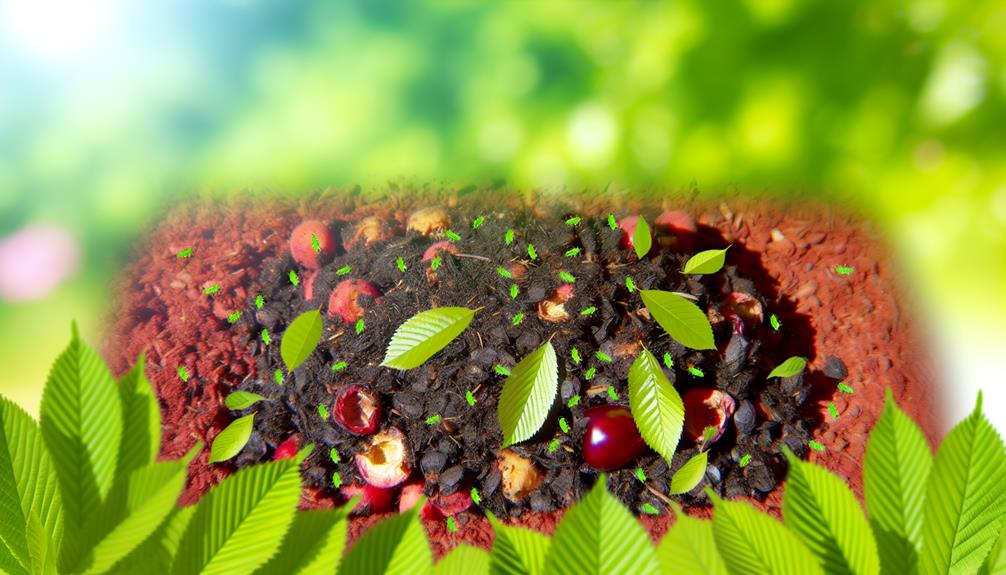

Yes, you can compost cherries, but it’s advisable to prepare them first. Remove the stems and pits, as pits decompose slowly. Chopping cherries into smaller pieces speeds up the process. The fleshy parts and skins of cherries provide beneficial nutrients for your compost, enhancing soil fertility.
However, make sure you balance the compost with both green and brown materials and maintain proper moisture levels. Stirring the pile regularly helps decomposition. Composting cherries makes your soil richer and helps retain moisture. Interested in optimizing your composting efforts? Keep going to discover more tips and techniques!
Composting cherries can greatly enhance your soil’s nutrient content and improve overall garden health. When you add cherries to your compost pile, you’re contributing to soil enrichment by providing essential nutrients like nitrogen, potassium, and phosphorus. These nutrients are crucial for plant growth and can lead to healthier, more vibrant plants in your garden.
Moreover, composting cherries is an excellent way to practice waste reduction. Instead of letting cherry pits, stems, and overripe cherries end up in a landfill, you can turn these organic materials into valuable compost. This not only reduces the amount of waste you produce but also helps lower your carbon footprint, making your gardening practices more sustainable.
It’s also worth noting that cherries break down relatively quickly in a compost pile, especially when chopped into smaller pieces. This means you’ll see the benefits of soil enrichment sooner rather than later. Your garden will thank you with better moisture retention, reduced soil erosion, and improved soil structure.
To prepare cherries for compost, start by removing any stems and pits to guarantee a smoother decomposition process. This step is important because stems and pits decompose more slowly and can hinder the overall breakdown of the organic material.

Begin by grasping each cherry and gently twisting to detach the stem. If you have a lot of cherries, you might find it helpful to use a de-stemmer tool.
Next, focus on peeling cherries if you notice any that are overly tough or thick-skinned. Peeling isn’t always necessary, but it can speed up the composting process. Use a paring knife to remove the outer layer gently. This step ensures that even the tougher parts of the cherry break down efficiently.
Once the stems are removed and any necessary peeling is done, you can chop the cherries into smaller pieces. This increases the surface area exposed to microorganisms, promoting faster decomposition.
Also Read: Can You Compost Celery?
Now that the cherries are prepped, let’s tackle the question of whether cherry pits can go into your compost pile. Yes, cherry pits are compostable, but there are some important considerations to keep in mind for composting safety and pest control.
Cherry pits are quite hard and can take years to break down completely in a standard compost pile. This prolonged decomposition process mightn’t align with your composting goals if you aim for quick results. However, if you don’t mind the wait, adding cherry pits to your compost is perfectly safe. They won’t harm your pile and will eventually break down, providing long-term benefits to your compost.
To prevent potential pest issues, make sure the pits are well-covered within the compost pile. Exposed pits can attract rodents and other pests, disrupting your composting process. It’s also helpful to mix them with other organic materials to make sure they’re not easily accessible.
While cherry pits are safe for composting, keep in mind the time and effort required for their decomposition. If you’re aiming for a faster turnaround, you might consider other methods or simply composting the cherry flesh and stems instead.
Also Read: Can You Compost Apricot Pit?
Lastly, balance the carbon-nitrogen ratio by mixing in green and brown materials.
Finally, ensure proper moisture levels, ensuring the compost is damp but not waterlogged.
Lastly, start by chopping up the pits to increase their surface area to speed up the decomposition of cherry compost.
Chopping cherry pits into smaller pieces can greatly accelerate their decomposition process in your compost pile. Using an effective chopping technique, you can break down the tough exterior of each cherry pit, making it easier for microorganisms to do their work.
Begin by placing the pits on a sturdy surface and using a hammer or mallet to crack them open. This physical breakdown increases the surface area exposed to decomposers, speeding up the composting process.
Here’s a step-by-step guide to help you visualize:
| Step | Tool | Action |
|---|---|---|
| 1 | Mallet | Place cherry pits on a hard surface |
| 2 | Mallet | Lightly tap to crack the outer shell |
| 3 | Knife | Chop the cracked pits into smaller pieces |
| 4 | Gloves | Wear gloves to protect your hands |
| 5 | Compost bin | Add the chopped pieces to your compost |
As you add the chopped cherry pits to your compost bin, ensuring the right moisture levels will greatly enhance the decomposition process. Proper moisture retention is key, as too much or too little water can slow down the breakdown of organic materials.
First, check the moisture level by squeezing a handful of compost. It should feel like a damp sponge—moist but not dripping. If it’s too dry, sprinkle water evenly over the compost. Use a garden hose with a spray nozzle for better water management.
On the other hand, if the compost is too wet, mix in dry materials like straw or shredded newspaper to absorb excess moisture.
Turning the compost regularly helps maintain uniform moisture levels. It also introduces oxygen, which aids in decomposition. Aim to turn the pile every one to two weeks.
Covering your compost with a tarp can help manage moisture retention, especially during rainy periods.
Balancing the carbon-nitrogen ratio in your compost pile is crucial for speeding up the decomposition process. To achieve this, you’ll need a mix of carbon sources and nitrogen content.
Carbon sources, often referred to as ‘browns,’ include materials like dried leaves, straw, and cardboard. These provide the necessary energy for microorganisms to break down your compost.
On the other hand, nitrogen content, or ‘greens,’ includes kitchen scraps like cherry pits, fruit peels, and grass clippings, which supply the protein needed for microbial growth.
Aim for a carbon to nitrogen ratio of about 30:1. This balance guarantees that decomposition occurs efficiently without producing unpleasant odors. If your pile has too much nitrogen, it may smell like ammonia. Conversely, too much carbon can slow down the process.
To fine-tune your compost, layer browns and greens, starting with a base of carbon sources. Add greens in thinner layers to avoid clumping. Regularly turning your pile helps maintain this balance and introduces oxygen, further speeding up decomposition.
Monitor your compost and adjust as needed; you’ll create a rich, earthy compost that benefits your garden and reduces waste.
One potential drawback of composting cherry pits is their slow decomposition rate. Cherry pits are hard and woody, taking years to break down fully. This can be frustrating if you’re looking for quick compost. To help speed up this process, you can try crushing or grinding the pits before adding them to your compost pile.
Another issue you might face is an increase in fruit flies. When cherries start to decompose, the sweet smell can attract these pesky insects. To combat this, make sure you bury the cherry scraps deep within the compost pile. This helps minimize exposure and reduces the chances of attracting fruit flies.
Mold growth is another concern. Cherry remnants provide a moist environment ideal for mold. While mold isn’t inherently bad for compost, it can be off-putting and may even cause respiratory issues if inhaled. To manage mold, make certain your compost pile has a good balance of green and brown materials and turn it regularly to improve aeration.
Also Read: Can You Compost Blood?
Despite these challenges, you can still reap significant benefits by using cherry compost in your garden. The fermentation process breaks down cherry waste, transforming it into rich, organic matter that greatly enhances soil enrichment. This compost adds essential nutrients back into the soil, promoting healthier plant growth and improving soil structure.

To use cherry compost effectively, spread a layer of it over your garden beds and mix it into the top few inches of soil. Doing this helps your plants access the nutrients more easily. The cherry compost will also improve water retention in sandy soils and drainage in clay soils, creating a more balanced environment for plant roots.
When you incorporate cherry compost, you’re fostering a sense of community within your garden. The enriched soil supports a diverse ecosystem of beneficial microorganisms, insects, and plants. This harmony enhances plant resilience against diseases and pests, reducing the need for chemical interventions.
Remember to monitor your soil’s pH levels, as cherry compost can be slightly acidic. If necessary, balance it with lime or other alkaline amendments.
Yes, composting cherries can attract pests if not managed properly. To guarantee pest prevention, bury the cherries deep in the compost and regularly turn it to minimize compost odor. You’ll keep pests away and maintain a healthy compost.
You can transform overripe cherries into delicious homemade jams or cherry sauces. By doing so, you’ll not only reduce waste but also enjoy the fruits of your labor and share them with friends and family.
You can compost cherries in a worm bin, but be mindful of the cherry pits. Worms can handle them, but it’s better to chop cherries up first. This helps balance the worm diet and keeps your bin thriving.
Yes, cherries can affect the pH balance of compost. They increase soil acidity and boost nitrogen levels, which enriches the compost. Don’t worry, though; your composting community will benefit from these nutrients.
When composting moldy cherries, you should consider mold toxicity. Spoiled produce can introduce harmful molds, so it’s best to balance them with dry materials. Don’t worry, your compost community will handle it safely if managed well.
To sum up, you can compost cherries effectively by following these steps:
By following these guidelines, you will turn cherry waste into nutrient-rich compost, ultimately benefiting your garden.
Follow these tips, and you’ll successfully compost cherries, enhancing your soil quality.
